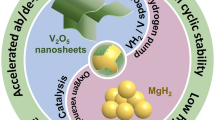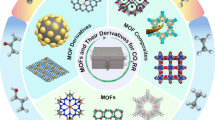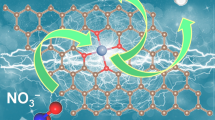Abstract
Nitrogen dope mesoporous carbon materials are widely used in the designing of oxygen reduction reaction (ORR) catalysts. How to prepare nitrogen-doped carbons (NC) with broad mass transfer path and preserve abundant ORR active nitrogen functionalities is still a great challenge. Here, nitrogen-doped mesoporous carbon materials are obtained through simply pyrolysis a mixture of renewable biomass (tofu) and ZnCl2. Owing to the effective chemical activation effect during carbonization, the optimal NC could present high porosity (high surface area of 1062 m2 g−1, large pore volume of 0.97 cm3 g−1) and high nitrogen content (7.74 wt%). Benefit from the rich of nitrogen functionalities to create abundant active sites and the well-developed mesoporous structure (high mesopore area 825 m2 g−1 and dual mesopore system with mesopore in both 3 nm and 30 nm) to guarantee fast mass transport and electron transfer, the obtained NC could serve as fine metal-free ORR catalyst, accelerating oxygen reduction reaction via high efficient 4e− oxygen reduction pathway. And more important, NC showed higher stability than commercial Pt/C (20 wt%), which highlight its great potential in the designing of electrocatalyst.





Similar content being viewed by others
References
Jia Y, Zhang L, Du A et al (2016) Defect graphene as a trifunctional catalyst for electrochemical reactions. Adv Mater 28:9532–9538
Wang R, Wang K, Wang Z, Song H, Wang H, Ji S (2015) Pig bones derived N-doped carbon with multi-level pores as electrocatalyst for oxygen reduction. J Power Sources 297:295–301
Wang R, Wang H, Zhou T, Key J, Ma Y, Zhang Z, Wang Q, Ji S (2015) The enhanced electrocatalytic activity of okara-derived N-doped mesoporous carbon for oxygen reduction reaction. J Power Sources 274:741–747
You C, Zheng R, Shu T, Liu L, Liao S (2016) High porosity and surface area self-doped carbon derived from polyacrylonitrile as efficient electrocatalyst towards oxygen reduction. J Power Sources 324:134–141
Liang HW, Zhuang X, Brüller S et al (2014) Hierarchically porous carbons with optimized nitrogen doping as highly active electrocatalysts for oxygen reduction. Nat Commun 5:4973
Pampel J, Fellinger TP (2016) Opening of bottleneck pores for the improvement of nitrogen doped carbon electrocatalysts. Adv Energy Mater 6:1502389
Zhang LY, Wang MR, Lai YQ, Li XY (2017) Nitrogen-doped microporous carbon: an efficient oxygen reduction catalyst for Zn-air batteries. J Power Sources 359:71–79
Ludwinowicz J, Jaroniec M (2015) Effect of activating agents on the development of microporosity in polymeric-based carbon for CO2 adsorption. Carbon 94:673–679
Xing T, Zheng Y, Li LH, Cowie BCC, Gunzelmann D, Qiao SZ, Huang S, Chen Y (2014) Observation of active sites for oxygen reduction reaction on nitrogen-doped multilayer graphene. ACS Nano 8:6856–6862
Yang HB, Miao J, Hung SF, Chen J, Tao HB, Wang X, Zhang L, Chen R, Gao J, Chen HM, Dai L, Liu B (2016) Identification of catalytic sites for oxygen reduction and oxygen evolution in N-doped graphene materials: development of highly efficient metal-free bifunctional electrocatalyst. Sci Adv 2:e1501122
Guo D, Shibuya R, Akiba C et al (2016) Active sites of nitrogen-doped carbon materials for oxygen reduction reaction clarified using model catalysts. Science 351:362–365
Lee S, Choun M, Ye Y, Lee J, Mun Y, Kang E, Hwang J, Lee YH, Shin CH, Moon SH, Kim SK, Lee E, Lee J (2015) Designing a highly active metal-free oxygen reduction catalyst in membrane electrode assemblies for alkaline fuel cells: effects of pore size and doping-site position. Angew Chem Int Ed 54:9230–9234
Zheng Y, Jiao Y, Qiao SZ (2015) Engineering of carbon-based electrocatalysts for emerging energy conversion: from fundamentality to functionality. Adv Mater 27:5372–5378
Tian GL, Zhang Q, Zhang B, Jin YG, Huang JQ, Su DS, Wei F (2014) Toward full exposure of “active sites”: nanocarbon electrocatalyst with surface enriched nitrogen for superior oxygen reduction and evolution reactivity. Adv Funct Mater 24:5956–5961
Tang J, Liu J, Li C, Li Y, Tade MO, Dai S, Yamauchi Y (2015) Synthesis of nitrogen-doped mesoporous carbon spheres with extra-large pores through assembly of diblock copolymer micelles. Angew Chem Int Ed 54:588–593
Wang Q, Li Y, Wang K, Zhou J, Zhu L, Gu L, Hu J, Cao X (2017) Mass production of porous biocarbon self-doped by phosphorus and nitrogen for cost-effective zinc–air batteries. Electrochim Acta 257:250–258
Cao L, Lin Z, Huang J, Yu X, Wu X, Zhang B, Zhan Y, Xie F, Zhang W, Chen J, Xie W, Mai W, Meng H (2017) Nitrogen doped amorphous carbon as metal free electrocatalyst for oxygen reduction reaction. Int J Hydrog Energy 42:876–885
Zheng X, Cao X, Li X, Tian J, Jin C, Yang R (2017) Biomass lysine-derived nitrogen-doped carbon hollow cubes via a NaCl crystal template: an efficient bifunctional electrocatalyst for oxygen reduction and evolution reactions. Nanoscale 9:1059–1067
Li X, Fang Y, Zhao S, Wu J, Li F, Tian M, Long X, Jin J, Ma J (2016) Nitrogen-doped mesoporous carbon nanosheet/carbon nanotube hybrids as metal-free bi-functional electrocatalysts for water oxidation and oxygen reduction. J Mater Chem A 4:13133–13141
Ouyang T, Cheng K, Gao Y, Kong S, Ye K, Wang G, Cao D (2016) Molten salt synthesis of nitrogen doped porous carbon: a new preparation methodology for high-volumetric capacitance electrode materials. J Mater Chem A 4:9832–9843
Lee DY, An GH, Ahn HJ (2017) High-surface-area tofu based activated porous carbon for electrical double-layer capacitors. J Ind Eng Chem 52:121–127
Wang Y, Pan Y, Zhu L, Guo N, Wang R, Zhang Z, Qiu S (2019) Structure regulation of amino acids derived nitrogen doped porous carbon nanosheet through facile solid state assembly method. Microporous Mesoporous Mater 277:36–44
Boyjoo Y, Cheng Y, Zhong H, Tian H, Pan J, Pareek VK, Jiang SP, Lamonier JF, Jaroniec M, Liu J (2017) From waste Coca Cola® to activated carbons with impressive capabilities for CO2 adsorption and supercapacitors. Carbon 116:490–499
Yue Z, Mangun CL, Economy J (2002) Preparation of fibrous porous materials by chemical activation: 1. ZnCl2 activation of polymer-coated fibers. Carbon 40:1181–1191
Rossi F, Felis GE, Martinelli A, Calcavecchia B, Torriani S (2016) Microbiological characteristics of fresh tofu produced in small industrial scale and identification of specific spoiling microorganisms (SSO). LWT-Food Sci Technol 70:280–285
Zhu Q, Wu F, Saito M, Tatsumi E, Yin L (2016) Effect of magnesium salt concentration in water-in-oil emulsions on the physical properties and microstructure of tofu. Food Chem 201:197–204
Sun X, Ye J, Pan F, Xu J, Cheng T, Wang X, Ikram M, Zhu Y (2018) Hierarchical porous carbon obtained from frozen tofu for efficient energy storage. New J Chem 42:12421–12428
An GH, Lee DY, Ahn HJ (2017) Tofu-derived carbon framework with embedded ultrasmall tin nanocrystals for high-performance energy storage devices. J Alloys Compd 722:60–68
Wang H, Wang C, Xiong Y et al (2017) Simple synthesis of N-doped interconnected porous carbon from Chinese tofu for high-performance supercapacitor and lithium-ion battery applications. J Electrochem Soc 164:A3832–A3839
Ai K, Liu Y, Ruan C, Lu L, Lu GM (2013) Sp2 C-dominant N-doped carbon sub-micrometer spheres with a tunable size: a versatile platform for highly efficient oxygen-reduction catalysts. Adv Mater 25:998–1003
Shen M, Zheng LR, He W, Ruan C, Jiang C, Ai K, Lu L (2015) High-performance oxygen reduction electrocatalysts derived from uniform cobalt-adenine assemblies. Nano Energy 17:120–130
Jeon I, Zhang S, Zhang L, Choi H, Seo J, Xia Z, Dai L, Baek J (2013) Edge-selectively sulfurized graphene nanoplatelets as efficient metal-free electrocatalysts for oxygen reduction reaction: the electron spin effect. Adv Mater 25:6138–6145
Dai L, Xue Y, Qu L, Choi HJ, Baek JB (2015) Metal-free catalysts for oxygen reduction reaction. Chem Rev 115:4823–4892
Wang Y, Zou H, Zeng S, Pan Y, Wang R, Wang X, Sun Q, Zhang Z, Qiu S (2015) A one-step carbonization route towards nitrogen-doped porous carbon hollow spheres with ultrahigh nitrogen content for CO2 adsorption. Chem Commun 51:12423–12426
Gao S, Geng K, Liu H, Wei X, Zhang M, Wang P, Wang J (2015) Transforming organic-rich amaranthus waste into nitrogen-doped carbon with superior performance of the oxygen reduction reaction. Energy Environ Sci 8:221–229
Jiao Y, Zheng Y, Jaroniec M, Qiao SZ (2014) Origin of the electrocatalytic oxygen reduction activity of graphene-based catalysts: a roadmap to achieve the best performance. J Am Chem Soc 136:4394–4403
Zhao Z, Li M, Zhang L, Dai L, Xia Z (2015) Design principles for heteroatom-doped carbon nanomaterials as highly efficient catalysts for fuel cells and metal-air batteries. Adv Mater 27:6834–6840
Tang C, Zhang Q (2017) Nanocarbon for oxygen reduction electrocatalysis: dopants, edges, and defects. Adv Mater 29:1604103
Xia W, Mahmood A, Liang Z, Zou R, Guo S (2016) Earth-abundant nanomaterials for oxygen reduction. Angew Chem Int Ed 55:2650–2676
Kong A, Fan X, Chen A, Zhang H, Shan Y (2017) Mesoporous nitrogen-doped carbon microfibers derived from Mg-biquinoline-dicarboxy compound for efficient oxygen electroreduction. J Solid State Chem 246:399–403
Ishii T, Maie T, Kimura N, Kobori Y, Imashiro Y, Ozaki JI (2017) Enhanced catalytic activity of nanoshell carbon co-doped with boron and nitrogen in the oxygen reduction reaction. Int J Hydrog Energy 42:15489–15496
Lu X, Li Z, Yin X, Wang S, Liu Y, Wang Y (2017) Controllable synthesis of three-dimensional nitrogen-doped graphene as a high performance electrocatalyst for oxygen reduction reaction. Int J Hydrog Energy 42:17504–17513
Wang Q, Hu W, Huang Y (2017) Nitrogen doped graphene anchored cobalt oxides efficiently bi-functionally catalyze both oxygen reduction reaction and oxygen revolution reaction. Int J Hydrog Energy 42:5899–5907
Wang Y, Pan Y, Zhu L, Guo N, Wang R, Zhang Z, Qiu S (2018) Fabrication of 3D heteroatom-doped porous carbons from self-assembly of chelate foams via a solid state method. Inorg Chem Front 5:656–664
Funding
This study received funding from the Education Department of Jilin Province (2016299).
Author information
Authors and Affiliations
Corresponding author
Additional information
Publisher’s note
Springer Nature remains neutral with regard to jurisdictional claims in published maps and institutional affiliations.
Electronic supplementary material
ESM 1
(DOCX 704 kb)
Rights and permissions
About this article
Cite this article
Mu, L., Wang, R. & Tang, C. Tofu-derived nitrogen-doped mesoporous carbon materials as metal-free catalyst for oxygen reduction reaction. Biomass Conv. Bioref. 9, 401–409 (2019). https://doi.org/10.1007/s13399-019-00378-5
Received:
Revised:
Accepted:
Published:
Issue Date:
DOI: https://doi.org/10.1007/s13399-019-00378-5




